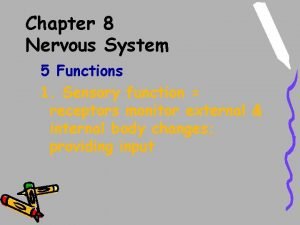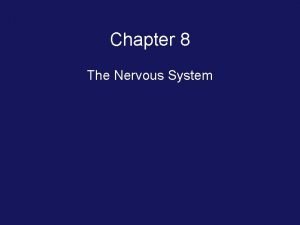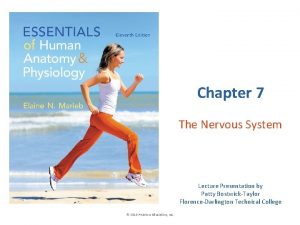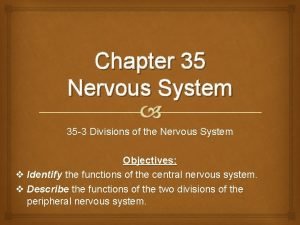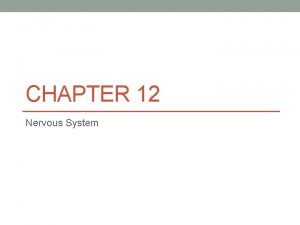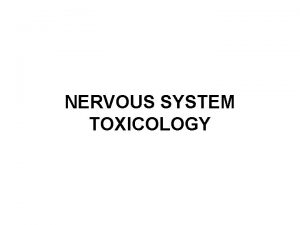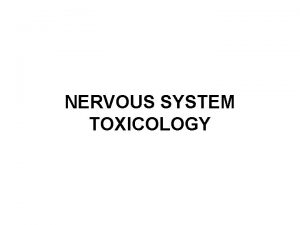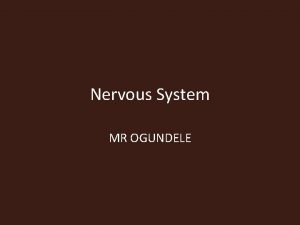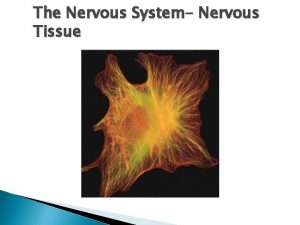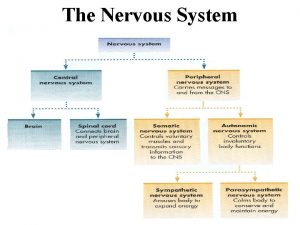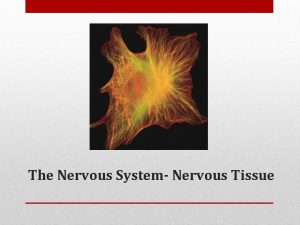Chapter 33 The Nervous System Nervous System Functions
























- Slides: 24

Chapter 33 The Nervous System

Nervous System Functions 1. Receive & relay information throughout body 2. Monitor & respond to internal and external changes

Nerve /Brain Facts We can’t make new neurons The brain is made up of 100 billion neurons We make new nerve connections when we learn

Nerve/Brain Facts (cont. ) We use 100% of our brain Nerve impulses can travel 395 feet per second

Bundles of nerve fibers

What are neurons? Cells that carry electrical nerve impulses throughout body

Anatomy of a Neuron Dendrite: receives nerve impulse

Anatomy of a Neuron (cont. ) Axon: sends nerve impulse


Anatomy of a Neuron (cont. ) Myelin Sheath: membrane surrounding axon • faster nerve conduction

Anatomy of a Neuron (cont. ) Cell Body: contains organelles • mitochondria, nucleus, etc.

Neuron

How Neurons Work Neurons have a gap between them: synapse Neurotransmitters: chemicals that carry impulses between neurons

Common Neurotransmitters Acetylcholine: muscle contraction Dopamine: Too much schizophrenia, too little Parkinson's Norepinephrine: heart rate & blood pressure Serotonin: too little depression (found in tryptophan / amino acid) Histamine – triggers inflammatory response in immune system Epinephrine - increases heart rate, constricts blood vessels, dilates air passages and participates in the fight or flight response GABA – too little linked to anxiety

Neurotransmitters

Neurotransmitters

Types of Neurons 1. Sensory neurons 2. Motor neurons

1. Sensory Neurons Carry impulses to brain and spinal cord

2. Motor Neurons Carry impulses from the brain and spinal cord to muscles or glands

Epilepsy • Seizures due to large numbers of impulses sent simultaneously • Affects 1 out of every 200 people in U. S. & 50 million people worldwide

Multiple Sclerosis Body attacks myelin sheath Causes nerve impulses to short circuit

Studying The Brain CAT Scan: used to locate tumors, damaged regions & blood clots AKA CT Scan

Studying The Brain (cont. ) PET Scan: used to look at brain activity

Studying The Brain (cont. ) MRI: used to look at brain tissue MRI of an individual with MS
 Which neuron is rare
Which neuron is rare Sensory input and motor output
Sensory input and motor output Processes neuron
Processes neuron What are the three basic functions of the nervous system
What are the three basic functions of the nervous system 5 functions of the nervous system
5 functions of the nervous system Chapter 7 the nervous system
Chapter 7 the nervous system Chapter 15 nervous system diseases and disorders
Chapter 15 nervous system diseases and disorders Chapter 8 the nervous system
Chapter 8 the nervous system Chapter 7 the nervous system figure 7-2
Chapter 7 the nervous system figure 7-2 Chapter 35 nervous system
Chapter 35 nervous system Chapter 14 skeletal muscular and nervous systems
Chapter 14 skeletal muscular and nervous systems Chapter 12 nervous system
Chapter 12 nervous system Nervous system and digestive system
Nervous system and digestive system Endocrine system vs nervous system
Endocrine system vs nervous system Endo crine gland
Endo crine gland Endocrine system
Endocrine system Hát kết hợp bộ gõ cơ thể
Hát kết hợp bộ gõ cơ thể Slidetodoc
Slidetodoc Bổ thể
Bổ thể Tỉ lệ cơ thể trẻ em
Tỉ lệ cơ thể trẻ em Voi kéo gỗ như thế nào
Voi kéo gỗ như thế nào Tư thế worms-breton
Tư thế worms-breton Chúa sống lại
Chúa sống lại Các môn thể thao bắt đầu bằng tiếng bóng
Các môn thể thao bắt đầu bằng tiếng bóng Thế nào là hệ số cao nhất
Thế nào là hệ số cao nhất




